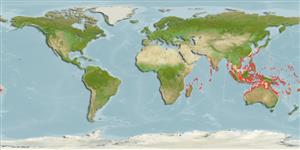Teleostei (teleosts) >
Ovalentaria/misc (Various families in series Ovalentaria) >
Pomacentridae (Damselfishes) > Chrominae
Etymology: Chromis: Greek, chromis = a fish, perhaps a perch (Ref. 45335).
More on author: Günther.
Environment: milieu / climate zone / depth range / distribution range
Ecology
Marine; reef-associated; non-migratory; depth range 4 - 40 m (Ref. 7247). Tropical
Indian Ocean: South Africa to Kenya, Maldives to the Andaman Sea and Australia. Previous reports from the Western Pacific (Taiwan, eastern Australia and Vanuatu Island) most probably refer fo Chromis xanthura (Ref. 129596).
Size / Weight / Age
Maturity: Lm ? range ? - ? cm
Max length : 17.0 cm TL male/unsexed; (Ref. 90102)
Dorsal spines (total): 13; Dorsal soft rays (total): 10 - 11; Anal spines: 2; Anal soft rays: 10 - 11. This species is distinguished by the following set of characters: D XIII,10-11 (mode 11); A II,10-11 (11); pectoral-fin rays 18-20 (19); upper and lower procurrent caudal-fin rays 3; pored lateral-line scales 17-18 (18); gill rakers 6-8 (7) + 19-22 (21) = 26-30 (28); the longest dorsal fin soft ray length 24.6-36.4% (mean 29.4%) of SL; first anal-fin spine length 6.5-8.4% (7.1%) of SL; caudal-fin length 43.9-59.8% (48.6%) of SL; posterior tips of caudal-fin lobes filamentous; presence of broad black bands along preopercular and opercular margins, sum width of two bands 15.3-27.9% (23.6%) of head length; in adults, the distal half of soft-rayed portion of dorsal fin is transparent; no triangular black blotches at the upper or lower caudal-fin base; caudal peduncle and fin are tinged yellow; soft-rayed portions of dorsal and anal fins are yellowish, while spinous portion of dorsal and pelvic fins dark blue in juveniles (Ref. 129596).
Adults inhabit outer reef slopes and deep lagoons (Ref. 9710). They form small to moderate aggregations on reef crests with moderate currents (Ref. 48636). Oviparous, distinct pairing during breeding (Ref. 205). Eggs are demersal and adhere to the substrate (Ref. 205). Males guard and aerate the eggs (Ref. 205).
Life cycle and mating behavior
Maturity | Reproduction | Spawning | Eggs | Fecundity | Larvae
Oviparous, distinct pairing during breeding (Ref. 205). Eggs are demersal and adhere to the substrate (Ref. 205). Males guard and aerate the eggs (Ref. 205).
Motomura, H., H. Nishiyama and S.N. Chiba, 2017. Review of the Chromis xanthura species group (Perciformes: Pomacentridae), with description of a new species. Ichthyol. Res. 65:177-191. (Ref. 129596)
IUCN Red List Status (Ref. 130435: Version 2024-1)
Threat to humans
Harmless
Human uses
Fisheries: of no interest
Tools
Can't connect to MySQL database fbquizv2. Errorcode: Too many connections
